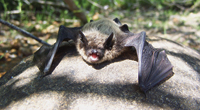
Scientific Name
Myotis lucifugus
Description
The little brown bat is the most common and widespread of Canada's nineteen species of bats. They are found across Canada to the northern edge of the boreal forest. Little brown bats weigh only seven to fourteen grams and have a wingspan of 22-27 centimetres. This species of bat is the one most closely associated with humans, as it is the most likely to take up residence in buildings.
Similar Species
Of the 18 other species of bats in Canada, many have similar characteristics. Visit our Bats 101 of our HelpTheBats.ca section for descriptions of each one.
Photo Gallery |
Range
The Little Brown Bat has the largest distribution of all Canadian bats. In Canada, it is found in all provinces and territories except Nunavut. It is most common in the northern half of the United States but has been observed in all continental states and Alaska. It is also found in the cooler mountainous areas of central Mexico.
Habitat
Even though Little Brown Bats do not usually migrate to destinations outside of Canada, individuals can move up to 1000 km from summer roosts to winter roosts where they hibernate. These winter roosts are called hibernacula. Hibernacula are generally in caves or abandoned mines, and are chosen for their high humidity and stable, above-freezing temperatures. The Little Brown Bat is a true hibernator (it slows down its metabolism, heart rate, and breathing).
Summer roosts can be a building for their maternity colonies but they also use tree cavities or other places that stay dark and warm during the day, like bat boxes.
Diet
Little Brown Bats feed on a great variety of small, flying insects and are capable of catching over 1000 insects in just one hour. Little brown bats feed on those that have an aquatic larval stage, such as mosquitoes, midges, and mayflies as well as moths, beetles, and other flying insects.
Behaviour
Bats use echolocation to navigate and find food as they fly. It works by sending out pulses of high-frequency sound that creates a returning echo when there is something in their path.
Most Little Brown Bats of more than one year old will mate in the fall when great groups swarm together. Individuals can mate several times with different partners. Females will store the males’ sperm throughout the winter until they ovulate in the spring.
After a gestation of 50 to 60 days, depending on the condition and age of the female, a single pup is born in June or July. It is born able to cling onto the roost’s wall and its mother. Little Brown Bat pups can fly at about three weeks old, after which it feeds both on its mother’s milk and insects. It is weaned from its mother’s milk at around 26 days, after which it accumulates fat for the winter before leaving for fall swarming sites.
Contrary to the myth that bats are blind, little brown bats have excellent vision. Although echolocation is important, they also use visual cues, especially during long distance migration.
There are a number of predators that feed on little brown bats, such as raccoons, hawks, owls, and snakes. They are dependent, therefore, on finding roosts that provide protection from these predators while still being close to food and water sources. Little brown bats form a strong attachment to their maternity site and will return year after year to the same location.
In the winter little brown bats move to caves and mines for hibernation. They find an area of the cave with high humidity and a constant temperature slightly above freezing. Forced to survive the winter on their stores of fat, bats slow their heartbeat from approximately 200 beats per minute to as low as 20 beats per minute to conserve energy. It is important that they are not disturbed while hibernating as this causes them to waste precious fat reserves. Extra arousals can leave them with insufficient energy to survive the winter.
Primary Ecosystem Roles
Little brown bats play an important role as predators of night flying insects.
Threats and/or What You Can Do
Pesticides harm bats by poisoning or reducing their food supply. They can also kill bats when farms are sprayed in the early evening when bats begin to hunt. Some farmers have been able to reduce their dependence on pesticides by welcoming bat colonies to their land with artificial roosting.
Overly groomed shorelines and the removal of large trees including dead or dying ones, is another concern in the form of habitat loss. If you have a shoreline, keep it as natural as possible to keep the water clean and to keep plants along the edge for their use as both a filter and insect habitat.
White-nose Syndrome is a disease that is killing alarmingly high numbers of bats that overwinter in caves. Scientists are working quickly to discover a cure.
Wind turbines kill large numbers of migratory bats each year. When choosing a wind turbine site, the migratory path of birds and bats needs to be considered.
If you would like to help bats in your area you can provide roosting sites by putting up a bat house. Little brown bats are one of the bats most likely to use bat houses. Find out more

This content is from Hinterland Who's Who, a joint program between the Canadian Wildlife Federation and Environment and Climate Change Canada. For more species fact sheets, videos and sound clips, please visit hww.ca







